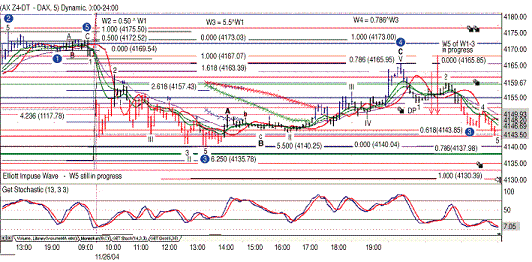Crowd Behavior And Elliott Waves
The Third Wave
by Mircea Dologa, Ph.D.
Does the crowd always behave the same way? According to Elliott wave theory, they do, and this is what forms the basis of the impulse pattern of five waves. Here's part 1 of a quick study.
When it comes to trading different types of trend waves, trading wave 3 in Elliott wave theory is the most profitable, even if the position may sometimes reach its maximum accepted limit. It's a question of observing all this unwinding (referred to as chaos by academics) in a tridimensional approach. In the first dimension, you must grasp the meaning of each trend's module. In the second, you must follow up on the functionality of the continuous developing mechanism. And in the third, you must trade -- that is, make decisions -- and preserve capital.
THE FRACTAL NATURE OF WAVES
In his wave theory, R.N. Elliott's major innovation pointed out that the crowd always behaves the same way, thus constituting the impulse pattern of five waves (noted as W1 through W5), immediately followed by correction pattern of three waves (noted as A, B, C). When all these waves (impulsive or corrective) contain themselves within multiple levels of subwaves, typically referred to as lesser-degree waves (Figures 1 and 2), you understand the fractal nature of the waves.

FIGURE 1: TYPICAL IMPULSE ELLIOTT PATTERN. On this five-minute chart, you can see the occurrence of Elliott wave patterns over a two-day period.
THE IMPLUSE PATTERN
After the low of a correction pattern, an impulse pattern usually follows. The first impulse wave could be a wave 1 or a wave A, and you'll see the required five lesser-degree waves. The main reason I equate wave 1 with wave A is because when an impulsive/corrective pattern starts, you don't really know which of the two it will be until the third wave is terminated. So to make things easier, I refer to the first wave as wave 1/A, the second wave as wave 2/B, and the third wave as wave 3/C.
If you don't see them, you should go to a shorter time frame. After that first impulse wave, a corrective wave 2 or wave B develops. This is in line with the alternation principle characterizing any correction pattern.
The next wave will be either an impulsive wave 3 or a wave C, which will differentiate between an impulse pattern and a corrective one. Wave 3 will be followed by a corrective W4. The impulse pattern's W5 ends this pattern.
Once the correction W2/B is terminated and the impulsive W3/C starts to form, you should draw the wave extensions.
SUGGESTED READING...Continued in the May issue of Technical Analysis of STOCKS & COMMODITIESBalan, Robert [1989]. Elliott Wave Principle Applied To The Foreign Exchange Markets, BBS Financial Publications.
Beckman, Robert C. [1995]. Elliott Wave Explained - A Real-World Guide To Predicting & Profiting From Market Turns, Probus Publishing.
Bright, Don [2002]. "The Professional Alternative," five-day NYSE stocks trading course, Las Vegas.
Brown, Constance [1999]. Technical Analysis For The Trading Professional, McGraw-Hill.
Ceaux-Dutheil, S. [2002]. "Bourse et analyse technique," Economica.
Copsey, Ian [1999]. Integrated Technical Analysis, John Wiley & Sons.
Crane, John [2003]. Advanced Swing Trading, John Wiley & Sons.
De Ducla, Olivier [2002]. "Elliott & Gann," Economica.
eSignal Advanced GET Manual [2003]. The Tools, The Power & The Knowledge.
Frost, A.J., and Robert R. Prechter [2000]. Elliott Wave Principle, New Classics Library.
Grant, Ray [2003]. "Futures Trading," three-day trading course, Orange County, CA.
Hill, John R., George Pruitt, and Lundy Hill [2000]. The Ultimate Trading Guide, John Wiley & Sons.
Leo, Paul, and Peter Temple [2003]. The Ultimate Technical Trading Software, John Wiley & Sons.
Mikula, Patrick [2002]. The Best Trendline Methods Of Alan Andrews And Five New Trendline Techniques, Austin Financial Group.
Miner, Robert C. [1989]. "Time, Price And Pattern," Technical Analysis of STOCKS & COMMODITIES, Volume 7: May.
_____ [1991]. "Time As A Trading Tool," Technical Analysis of STOCKS & COMMODITIES, Volume 9: March.
_____ [1991]. "Price As A Trading Tool," Technical Analysis of STOCKS & COMMODITIES, Volume 9: April.
_____ [1991]. "Form And Pattern As A Trading Tool," Technical Analysis of STOCKS & COMMODITIES, Volume 9: May.
_____ [1999]. Dynamic Trading, Dynamic Traders Group.
Neely, Glenn [1990]. Mastering Elliott Wave, Windsor Books and the Elliott Wave Institute.
Perfetti, Patrick [1997]. "Analyses techniques -- approche pragmatique," Economica.
Person, John L. [2004]. A Complete Guide To Technical Trading Tactics, John Wiley & Sons.
Poser Steven W. [2003]. Applying Elliott Wave Theory Profitably, John Wiley & Sons.
Walker, Myles Wilson [2001]. How To Identify High-Profit Elliott Wave Trades In Real Time, Windsor Books
Excerpted from an article originally published in the May 2006 issue
of Technical Analysis of STOCKS & COMMODITIES magazine.
All rights reserved. © Copyright 2006, Technical Analysis,
Inc.
Return to May 2006 Contents